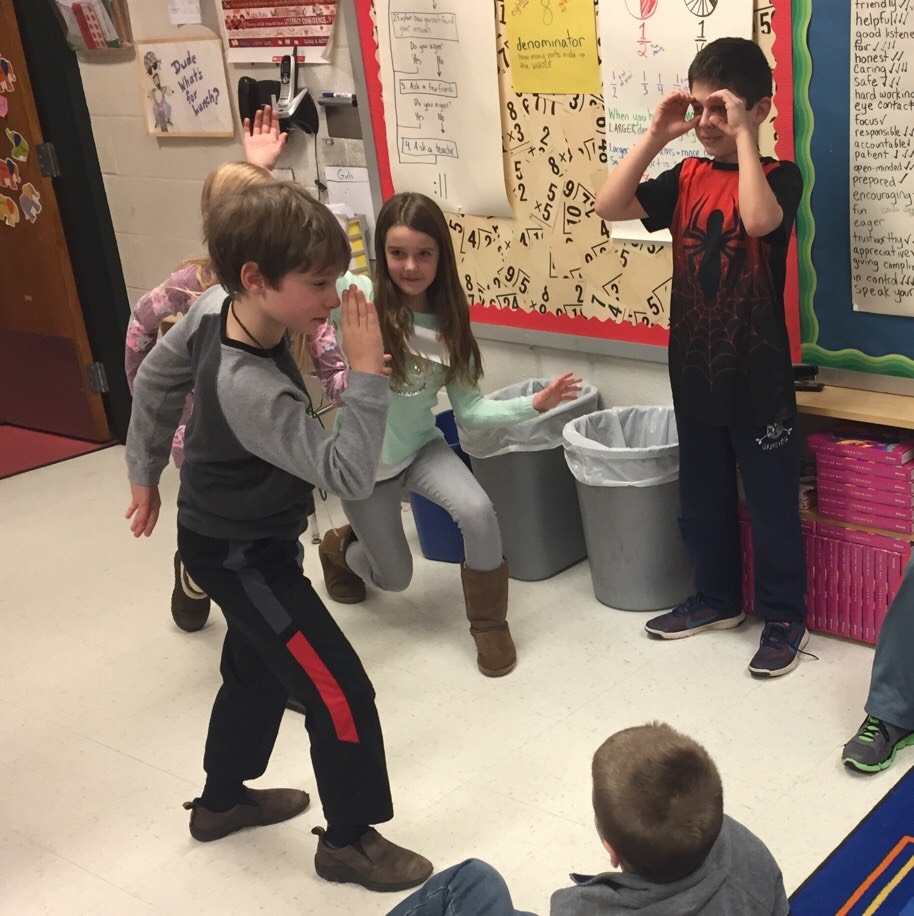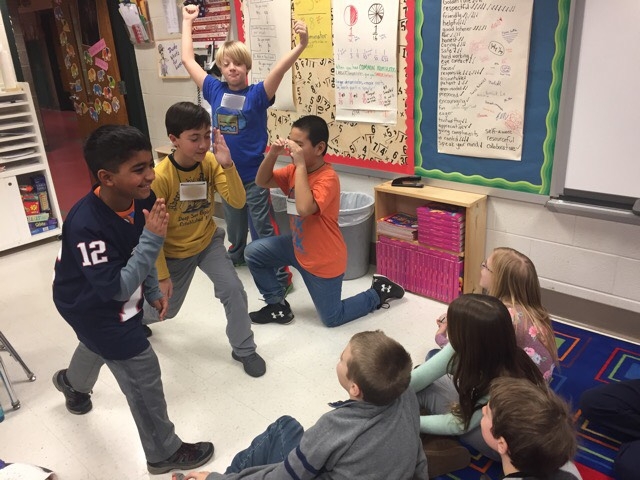Update on Number the Stars (Day 2 of 5)
January 23, 2017 | Posted in: Class Updates
Comments Off on Update on Number the Stars (Day 2 of 5)
 Today, Aurelia from The Hartford Stage came for our second day of learning about Number the Stars. The kids began by pantomiming several scenes, such as acting in a school play, blowing out the candles on a birthday cake, etc. The kids really enjoyed figuring out how to act out those scenes, especially since these moments were so familiar to them. Following these tableaux, Aurelia led the students in a safe discussion about what was happening in and around Copenhagen (the setting of the story) in the 1930s. She introduced the concept of the Holocaust, and I was surprised by how much many students already knew. She explained that Hilter looked for someone to blame for the problems happening in Germany and that the Jews were made into scapegoats. She shared that, eventually, many of the Jews were rounded up and sent to concentration camps where many worked and many perished. The kids took this topic seriously, and I admire their maturity during the discussion. I should say that there are times when students have additional prior knowledge and may start to share more sensitive information than what we’d normally choose to include. Aurelia and I both redirect the conversations when this happens, and we remind kids that some things are best discussed with families at home. There were a few instances of this today, and we were able to shift the focus back to what we were trying to address. In the event that something particularly sensitive is shared by a student in front of the whole class, I’ll, of course, give you a heads-up so you can be prepared for questions at home. On that note, today, a student brought up the idea of gas chambers. I tried to quickly move past this comment, as it’s not something that needs to be a focus in our unit.
Today, Aurelia from The Hartford Stage came for our second day of learning about Number the Stars. The kids began by pantomiming several scenes, such as acting in a school play, blowing out the candles on a birthday cake, etc. The kids really enjoyed figuring out how to act out those scenes, especially since these moments were so familiar to them. Following these tableaux, Aurelia led the students in a safe discussion about what was happening in and around Copenhagen (the setting of the story) in the 1930s. She introduced the concept of the Holocaust, and I was surprised by how much many students already knew. She explained that Hilter looked for someone to blame for the problems happening in Germany and that the Jews were made into scapegoats. She shared that, eventually, many of the Jews were rounded up and sent to concentration camps where many worked and many perished. The kids took this topic seriously, and I admire their maturity during the discussion. I should say that there are times when students have additional prior knowledge and may start to share more sensitive information than what we’d normally choose to include. Aurelia and I both redirect the conversations when this happens, and we remind kids that some things are best discussed with families at home. There were a few instances of this today, and we were able to shift the focus back to what we were trying to address. In the event that something particularly sensitive is shared by a student in front of the whole class, I’ll, of course, give you a heads-up so you can be prepared for questions at home. On that note, today, a student brought up the idea of gas chambers. I tried to quickly move past this comment, as it’s not something that needs to be a focus in our unit.
 Toward the end of the activity, students thought about what sounds they’d hear in a war zone. Ideas included explosions, gun shots, car engines roaring, people shouting, etc. Students made a “sound circle” where they created a cacophony of the sounds they’d expect to hear during a time of war. Finally, one group of four students recreated the previous tableaux of those familiar moments, but this time, with the “soundtrack” of the sound circle. This helped the kids to imagine how so many of these familiar moments would be different during wartime. Kids shared how they’d feel if they had to live during these situations, and their comments were deep. As I said in a previous message, these students don’t have much understanding of ideas like war, persecution, or hatred, and activities like these help them to understand these concepts a bit better.
Toward the end of the activity, students thought about what sounds they’d hear in a war zone. Ideas included explosions, gun shots, car engines roaring, people shouting, etc. Students made a “sound circle” where they created a cacophony of the sounds they’d expect to hear during a time of war. Finally, one group of four students recreated the previous tableaux of those familiar moments, but this time, with the “soundtrack” of the sound circle. This helped the kids to imagine how so many of these familiar moments would be different during wartime. Kids shared how they’d feel if they had to live during these situations, and their comments were deep. As I said in a previous message, these students don’t have much understanding of ideas like war, persecution, or hatred, and activities like these help them to understand these concepts a bit better.
Following these activities, I always remind students of a few things: (1) They are completely safe. We’re studying events from our world’s history, and by learning about them, we can work to ensure that they never happen again. But they are absolutely safe in their homes, school, and community. (2) These topics should be discussed when there’s an adult there to facilitate the conversation. So this isn’t appropriate conversation for the lunchroom, playground, bus, etc. (3) There are some things that might be upsetting or alarming. Kids can always come to me if they’re feeling worried or anxious, and they can talk to their grownups at home as well.
